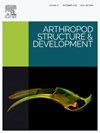Evolution and homology of leg segments in Chelicerata: Evo-devo solutions to century-old challenges
IF 1.3
3区 农林科学
Q2 ENTOMOLOGY
引用次数: 0
Abstract
A major theme in the evolution of Arthropoda is the origin and diversification of jointed appendages. One appealing framework for the evolution of arthropod appendage diversity has long been that a small network of homologous genes in the panarthropod ancestor established and subdivided the proximo-distal (PD) appendage axis, with lineage-specific modifications of these genes’ expression domains resulting in novel types of appendages. A corollary of this idea is the inference that each segment in the arthropod leg can be directly homologized to other such segments, based on anatomical or developmental genetic landmarks. Here, we explore the evolution of leg segments in Chelicerata, a group which exhibits marked diversity in leg architecture and number of leg segments, and thereby poses a greater challenge to the exercise of assigning segmental homologies. Focusing on the controversial nomenclature of leg segments in Pycnogonida (sea spiders), we identify potential markers of positional homology in different parts of the sea spider and arachnid PD axis, using comparative gene expression data. Nevertheless, we identify caveats to the use of transcription factor expression domains as landmarks for inference of positional homology, highlighting cases where datasets conflict in homology assignment. We postulate that the utility of gene expression data for inferring homologies is a function of phylogenetic distance.

Chelicerata腿节的进化和同源性:进化-进化解决百年挑战
节肢动物进化的一个重要主题是关节附属物的起源和多样化。长期以来,节肢动物附属物多样性进化的一个有吸引力的框架是,全节肢动物祖先中的一个同源基因的小网络建立并细分了近端-远端(PD)附属物轴,这些基因的表达域的谱系特异性修饰导致了新型的附属物。这种想法的一个推论是,节肢动物腿上的每个节段可以根据解剖学或发育遗传标志直接与其他节段同源。在这里,我们探讨了Chelicerata的腿节进化,这是一个在腿结构和腿节数量上表现出显著多样性的群体,因此对分配节同源性的练习提出了更大的挑战。针对海蜘蛛(Pycnogonida)腿段命名的争议,我们利用比较基因表达数据,确定了海蜘蛛和蛛形纲动物PD轴不同部位的潜在位置同源标记。尽管如此,我们确定了使用转录因子表达域作为推断位置同源性的标志的注意事项,突出了同源性分配中数据集冲突的情况。我们假设基因表达数据推断同源性的效用是系统发育距离的函数。
本文章由计算机程序翻译,如有差异,请以英文原文为准。
求助全文
约1分钟内获得全文
求助全文
来源期刊
CiteScore
3.50
自引率
10.00%
发文量
54
审稿时长
60 days
期刊介绍:
Arthropod Structure & Development is a Journal of Arthropod Structural Biology, Development, and Functional Morphology; it considers manuscripts that deal with micro- and neuroanatomy, development, biomechanics, organogenesis in particular under comparative and evolutionary aspects but not merely taxonomic papers. The aim of the journal is to publish papers in the areas of functional and comparative anatomy and development, with an emphasis on the role of cellular organization in organ function. The journal will also publish papers on organogenisis, embryonic and postembryonic development, and organ or tissue regeneration and repair. Manuscripts dealing with comparative and evolutionary aspects of microanatomy and development are encouraged.

 求助内容:
求助内容: 应助结果提醒方式:
应助结果提醒方式:


